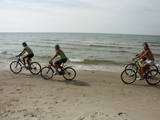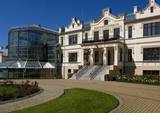| Нo | Название | Описание |
|---|---|---|
|
В хозяйстве можно осмотреть насаждения облепихи, в августе и в сентябре принять участие в сборе облепихи. Посетителям расскажут об облепихе, ее выращивании и сборе, целебных свойствах и продуктах. Предоставляется возможность осмотреть производство продуктов из облепихи и попробовать сами продукты. |
||
|
Маршрут «Балтийский путь»создан в честь уникальной акции, состоявшейся 23 августа 1989 года, во время которой жители трех стран взялись за руки и составили цепочку участников протяженностью около 600 км, соединившую столицы государств – Вильнюс, Ригу и Таллин. Исторически этот путь был известен и использовался еще в XIV–XV веках и даже раньше. В данном регионе блюда из злаков имеют древнюю историю, во многих местах пекут вкусный ржаной дрожжевой хлеб, в Видземе попробуйте его с конопляной пастой. Ячмень используют для выпечки карашей, варят в виде перловки и букстиньпутры (ячневой каши с картофелем). Из пшеничной муки выпекают водяные крендели с тмином. Путь зерна можно проследить в крестьянских хозяйствах и на восстановленных ветряных мельницах. К летнему солнцевороту во многих местах готовят Янов сыр, в обычные дни предлагаются и другие вкусные сыры из коровьего и козьего молока. Популярны приготовленная различными способами речная и озерная рыба, блюда из мяса местного домашнего скота и птицы, а также дичь, приправленная вкусными соусами. Дым живого огня придает сочному жаркому или горячему супу удивительный аромат. Гарнир – коренья и зелень, бобы, горох и грибы. В супы и салаты добавляют дикорастущие растения: щавель, листья одуванчика, сныти и молодой крапивы. Угоститесь свежим медом, пирожками со шпеком, открытыми пирогами, кренделями, десертом из ржаного хлеба, медовым тортом и пипаркукас. В предложении вы найдете и простые традиционные блюда, и романтические трапезы в замках и усадьбах, и специальное рыцарское угощение с использованием характерных для ливонских времен приправ. Жажду можно утолить травяными чаями, березовым соком, ягодными напитками, вкусным пивом, вином или стаканчиком более крепкого напитка. |
||
|
This part of the Forest Trail gives an opportunity to see Setomaa or “the Land of Setos” which is inhabited by Setos – an ethnographic group with specific ancient traditions and a unique language dialect. Forest Trail hikers can visit the traditional Setos homestead and enjoy Setos cuisine. The forests of the region are especially charming in early autumn, when the ground is coloured lilac by the blooming heather. There is a good chance to pick wild mushrooms and berries. One of the most beautiful sections of this trail in Setomaa leads along the River Piusa, where the river is surrounded by sandstone outcrops. You will also visit the Piusa caves. The tour will end in Värska resort – with its sanatorium and SPA, which use the strengths of local nature: mineral water and lake mud. Värska mineral water is well known in Estonia and elsewhere. |
||
|
Muiža sāka veidoties 16. gs. beigās (īpašnieki - Tīzenhauzeni, vēlāk Bēri), bet no 1753. g. tā kļūst par Mēdemu dzimtas īpašumu. Tagad redzamo muižas pili (mūsdienās tikai atliekas) cēla 1806. - 1810. g. klasicisma stilā (Johana Georga Ādama Berlica projekts) pēc itāļu izcelsmes Pēterburgas galma arhitekta Džakomo Kvarengi meta. Muižas īpašnieks tajā laikā bija Johana Frīdriha Mēdema dēls - Kristofs Johans Frīdrihs (saukts par Žanno). Elejas pilī bija savākti daudzi nozīmīgi Eiropas mākslinieku darbi, kā arī iekārtots izcils interjers. 18 muižas kompleksa ēkas nodedzināja Pirmā pasaules kara laikā (1915. g.) un līdz mūsdienām ir saglabājušies tikai nelieli pils pirmā stāva drupu fragmenti ar kaltiem portika kolonu kapiteļiem, pārvaldnieka māja (apskatāma no ārpuses), atsevišķas saimniecības ēkas un parks. No pils drupām pa aleju var aiziet līdz Tējas namiņam (bēdīgā stāvoklī). 0,5 km ziemeļos no pils drupām atrodas 1912. g. izveidotā Mēdemu dzimtas kapsēta. Elejas pils mūra žoga arkādē iemūrēts dobumakmens. |
||
|
Охраняемая морская территория Нида – Перконе является одной из биологически многообразных и важных с точки зрения охраны природы морских территорий на побережье открытой части Балтийского моря – здесь находятся выдающиеся территории рифов. В период миграции территорию пересекает большинство мигрирующих пород птиц, встречающихся в Латвии. Расположенная напротив Руцавского и Ницского края территория площадью 36 703 га особенно важна для защиты большого крохаля и малой чайки. Территория частично перекрывается морской частью природного парка «Папе» и включает морскую часть территории природного парка «Бернаты».
|
||
|
The Nemuna River divides up into two large streams at its estuary at Kuršių Marios, and this has established the Rusnė Island. This is a unique environmental territory with wetlands, streams, ancient rivers, lagoon lakes and flood plains which are important places for birds to nest and rest during migration season. Vast tracts of this territory are flooded each spring. The park includes the territory to the N and W of Rusne (lagoons, swamps, fishing ponds, Kuršių Marios).
|
||
|
Маршрут начинается и заканчивается в Каунасе, втором по величине городе Литвы, который был столицей страны с 1920 по 1939 год. В хозяйстве Тадаса Иванаускаса у парка Обелинес вы можете увидеть коллекцию из 300 сортов и видов растений, а в яблоневом саду растет одно из старейших деревьев - гинкго двулопастный. В Каунасе вы сможете увидеть самую старую - почти 360-летнюю - яблоню, высотой 8 метров, 285 см в обхвате на высоте 1,3 метра. В Каунасском ботаническом саду университета Витаутаса Великого обустроена самая большая оранжерея в Литве, а также находится коллекция растений старинных цветочных видов. Литовский институт садоводства проводит как научную, так и экспериментальную / производственную деятельность, здесь можно приобрести саженцы, а также сезонные фрукты и овощи. Хозяйство Гарси Тила предлагает приготовленные на домашней кухне «счастливые блюда», а также прогулку по своему 100-летнем саду с лекарственными травами. В ландшафтном и скульптурном парке Бурбишского поместья проходит ежегодный фестиваль тюльпанов. В музее деревни Клебонишкяй можно осмотреть дома, характерные для региона Аукштайтии. Ботанический сад Шяуляйского университета отображает растительное наследие, которое организовано в соответствии с довоенными, межвоенными и послевоенными периодами. В сельском музее Людвики и Станиславы Диджилю собраны традиционные литовские сорта яблонь, цветов и растений. Мемориальный музей А. Баранаускаса и А. Виенолиса-Жукаускаса в Аникщяйской области знакомит с культурой, литературой, историей, аграрной культурой и технической историей. Традиционный литовский цветочный сад можно увидеть в Мемориальном музее Броне Буйвидайте. В Аникщяе можно прогуляться по тропе среди верхушек деревьев и по парку лабиринтов, а также отправиться в поездку по Аукштайтской узкоколейкой железной дороге. В Ботаническом саду Траупе вы найдете коллекцию многолетних цветов, каменный сад, часы из цветов и декоративный бассейн с водными растениями. Интерьер поместья Тауенов украшен портретами семьи Радзивиллов, скульптурами, охотничьими трофеями и антикварным оружием. В Укмергском районе посетите Узугирскую усадьбу президента Антанаса Сметонаса, где в его честь оборудован мемориальный музей. В конце путешествия осмотрите Литовский музей под открытым небом, один из крупнейших (194 га) и богатейших (91 420 экспонатов) этнографических музеев под открытым небом в Европе. |
||
|
Выращивающее пряности хозяйство Ööbiku расположено в экологически чистом районе. Здесь занимаются биологическим выращиванием пряностей, ягод и овощей, а также их дальнейшей обработкой. Также хозяйство занимается сушкой корнеплодов, фруктов и ягод. |
||
|
The Forest Trail leads down from the highest point of the Haanja Upland. The most important sight on this route is the Suur Munamägi Hill – 318 m above sea level. The highest point of the Baltics with its observation tower provides its visitors with a splendid 50 km range view of the Estonian nature. The 150 year-old western taiga spruce forests grow on the slopes of Suur-Munamägi. Further on the trail circles around the southern part of Lake Vaskna, and continues down small country roads surrounded by solitary homesteads and small clusters of farms. The route ends in a small village, Tsiistre, where the Linen Museum is located. The museum has a collection of folk linen. Flax is one of the oldest cultural plants in Estonia and a few decades ago, blue flax fields were a common sight in southern Estonia. |
||
|
Vēstures avotos pirmoreiz minēta 1483. g. Pilsētas uzplaukums bija vērojams pēc dzelzceļa uzbūvēšanas 19. gs. beigās, kad barons Korfs sadalīja un iznomāja apbūvei muižas zemi. Pilsētas tiesības Priekule ieguva 1928. g. Pilsēta smagi cieta 2. pasaules kara pēdējos mēnešos, - t.s. Kurzemes katla laikā, kuru laikā tika sagrautas 410 no 450 ēkām. Mūsdienās tā ir neliela pilsētiņa ar mazstāvu apbūvi un nesteidzīgu dzīves ritmu. |
||
|
Уже в 1615 году Герцог Фридрих Кетлер (1569 – 1642) предоставил городу Бауска привилегию на строительство нового здания ратуши, что и было осуществлено, и уже в 17 веке на Рыночной площади возвышалась самая большая ратуша в герцогстве. В связи с недостатком средств в 1852 году была снесена башня, а в 1871 году – второй этаж. В конце 2011 года строительство нового здания ратуши было завершено, и теперь Бауска может гордиться новым туристическим объектом, который можно осмотреть также изнутри. В восстановленной ратуше можно взвеситься и обмериться в старинных единицах измерения – в локтях, ступнях, пудах, фунтах - и получить этому соответствующий сертификат. |
||
|
Крестьянское хозяйство «Иесалниеки-1» находится в Плявиньском крае Виеталвской волости. Основная сфера деятельности хозяйства – выращивание зерновых (рапс, ячмень, пшеница и травы). Общая площадь – 180 га. Интересен тот факт, что оба брата ведут хозяйство вместе и общими силами обрабатывают более 800 га. |
||
|
На керамическом производстве (работает с 1980 г.) из латвийской красной глины вручную делают разную хозяйственную посуду и предметы интерьера. Здесь ждут как туристические группы, так и отдельных путешественников, которым предлагают экскурсию с рассказом и осмотром производства, и самим попробовать изготовить сувениры из керамики. |
||
|
Находится на главной пешеходной улице города. Выпекают свадебные пирожные по бабушкиным рецептам, а также готовят всевозможные кондитерские изделия. Сотрудничают с местными производителями. Латышская кухня: Холодный суп, суп с фрикадельками, орехово - брусничные, клубнично - рабарбаровые свадебные пирожные, пирожки, открытые пирога и др. лакомства. |
||
|
Парк усадьбы Кретинга — один из старейших усадебных парков Литвы, сохранившихся с XVI–XVIII вв. Это парк смешанного стиля площадью 23 га. В южной части усадебного парка на месте бывшего фруктового сада установлен Астрономический календарь с солнечными часами, сформирована живая изгородь, проложены аллеи, разбиты клумбы, альпинарии, выращиваются коллекции георгинов, пионов, тюльпанов, восстанавливаются фрагменты розария, оборудованы пешеходные дорожки, места для отдыха. Отреставрированный фонтан усадьбы стал излюбленным местом для отдыха посетителей. |
||
|
Предлагают процесс рыбной ловли с вытягиванием невода на Нидском и Папском взморье, рыбалку в море (для 1 - 2 человек) и рыбалку зимой. После рыбной ловли следует копчение улова или приготовление ухи. |
||
|
Кафе в гостевом доме «Имулас»у дороги Кандава – Сабиле (9 км) в древней долине Абавы, в 5 километрах от Сабиле. Предлагаются латышские традиционные блюда, вкусные стейки, приготовленные на гриле с разными гарнирами, итальянская паста, а также блюда китайской кухни. |
||
|
Guests to the Dīķīši homestead in the Amata Parish will be greeted by several Samoyed dogs and intelligent little donkeys that will bring the guests to a place for glamping next to the pond. You can hike down two trails of different lengths of enjoy the opportunities that exist when Latvians share places where they find mushrooms and berries. A special adventure is creating artworks from natural materials that have been collected in the forest. The accommodations are appropriate for people who use a wheelchair. The lavatory has been adapted to the needs of such people, as well. People who are interested in cultural history can tour a collection of Latvian folk costumes, trying them on and organising their own photo session. People who enjoy extreme feelings will enjoy a ride on a quadricycle. If you love to go fishing, bring your own inventory. We organise fire rituals for birthdays and family celebrations, and we’ll also offer soup that has been cooked on a campfire, as well as a master class in cheesemaking. |
||
|
Eine Floßhauptstadt Lettlands mit dem jährlichen Flößerfest im Mai. |
||
|
Хозяйство Pūpoli находится на берегу Рижского морского залива ‒ в 50 м от моря. Посетители могут увидеть, как разделывают и коптят камбалу, рыбца, леща, окуня и другую рыбу, а также могут продегустировать и приобрести рыбу. |
||






















